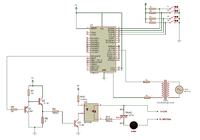atferrari
Full Member level 4
- Joined
- Jun 29, 2004
- Messages
- 237
- Helped
- 7
- Reputation
- 14
- Reaction score
- 3
- Trophy points
- 1,298
- Location
- Buenos Aires - Argentina
- Activity points
- 1,996
zero crossing pc814
Using a 18F452, I was planning to measure basic things in a 380 V tri phase system (basically V and I) to calculate power, besides frequency and eventually cos fi.
Obviously, I have experimented with different zero crossing circuits. But when I was about to start implementig it, my friend, who really knows a lot about, told me that nowadays, even zero crossing detection for V or I is made using no external hardware after the current transformers and eventually some simple filters. Just with micros.
How is that possible? I recall reading something about using the Schmit trigger in the inputs. Am I right? Got the feeling that the value obtained is not reliable, isn't it?
O should I do that in software? This last, seems to me, means continuous ADC conversions and testing with the inherent tremendous software overhead required for at least four (VR, IR, IS, IT) parameters.
In other forum I recall somebody advising to make a previous absolute value rectification to take advantage of the 10-bits resolution on the 0 - Vpk always positive range.
Yes, too many unknowns but once solved zero crossing detection and "absolute value yes or no" I think I could start experimenting.
Any concrete ideas? Gracias for any help.
PD: Just in case, I googled for months about, with no concrete details on the zero crossing with a micro only.
Using a 18F452, I was planning to measure basic things in a 380 V tri phase system (basically V and I) to calculate power, besides frequency and eventually cos fi.
Obviously, I have experimented with different zero crossing circuits. But when I was about to start implementig it, my friend, who really knows a lot about, told me that nowadays, even zero crossing detection for V or I is made using no external hardware after the current transformers and eventually some simple filters. Just with micros.
How is that possible? I recall reading something about using the Schmit trigger in the inputs. Am I right? Got the feeling that the value obtained is not reliable, isn't it?
O should I do that in software? This last, seems to me, means continuous ADC conversions and testing with the inherent tremendous software overhead required for at least four (VR, IR, IS, IT) parameters.
In other forum I recall somebody advising to make a previous absolute value rectification to take advantage of the 10-bits resolution on the 0 - Vpk always positive range.
Yes, too many unknowns but once solved zero crossing detection and "absolute value yes or no" I think I could start experimenting.
Any concrete ideas? Gracias for any help.
PD: Just in case, I googled for months about, with no concrete details on the zero crossing with a micro only.
